Marketing Strategy and Interrelationships: Dunkin' Donuts Report, UK
VerifiedAdded on 2022/12/27
|25
|5654
|40
Report
AI Summary
This report provides a comprehensive analysis of Dunkin' Donuts' marketing strategies, focusing on the UK market. It begins by explaining the key roles and responsibilities of the marketing function, exploring how marketing interrelates with other functional units such as finance, operations, and HR. The report delves into the marketing environment using SWOT and PESTEL analyses to assess internal strengths and weaknesses, as well as external opportunities and threats. Furthermore, it examines the application of the marketing mix (7Ps) to achieve business objectives. The report also covers the development of a basic marketing plan for Dunkin' Donuts, capturing the organization's mission, goals, and strategic marketing approach. The analysis includes a discussion of B2B and B2C marketing strategies and the significance of interrelationships between marketing and other functional units within the organization. The report concludes with a detailed marketing plan designed to meet the marketing objectives of Dunkin' Donuts.
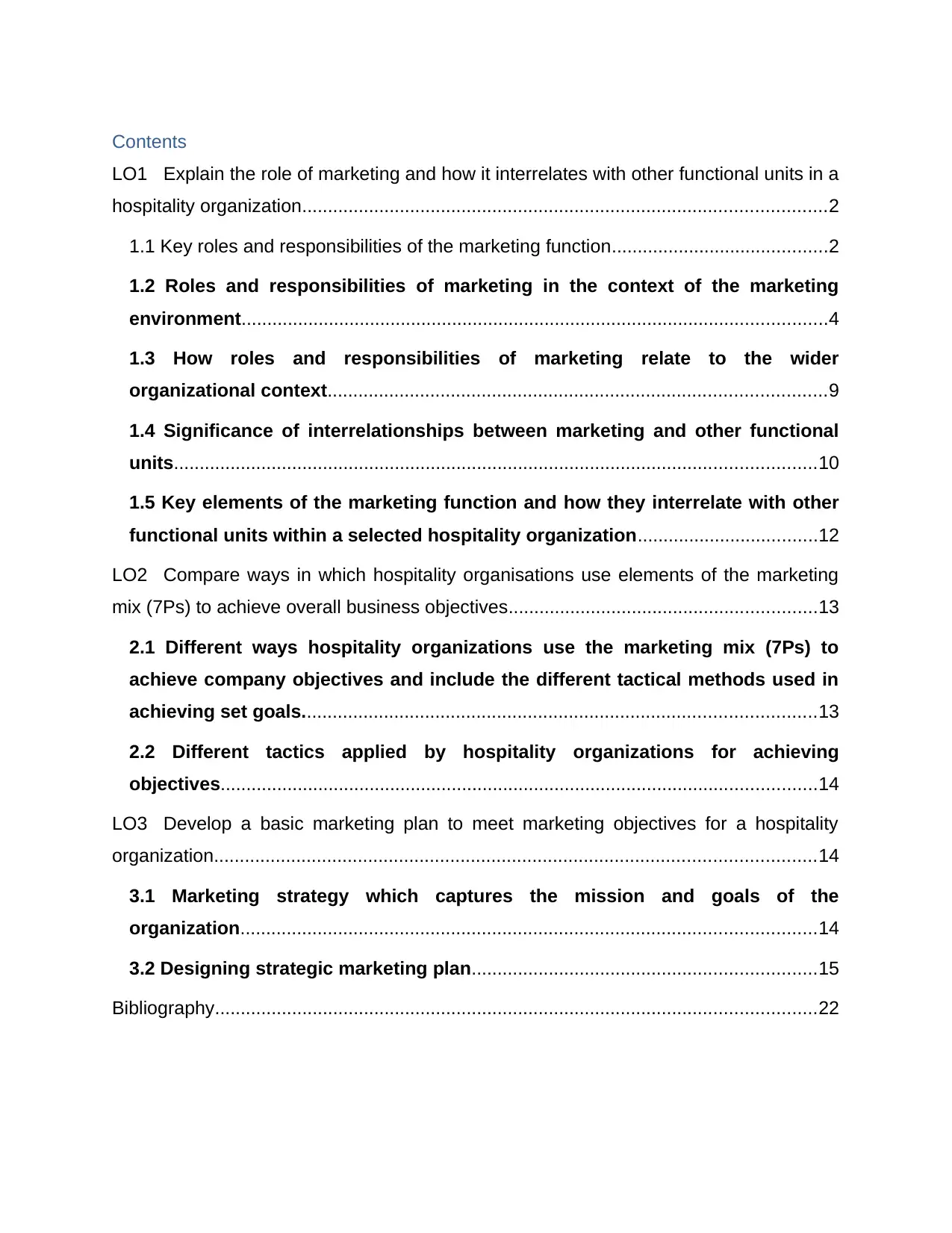
Contents
LO1 Explain the role of marketing and how it interrelates with other functional units in a
hospitality organization......................................................................................................2
1.1 Key roles and responsibilities of the marketing function..........................................2
1.2 Roles and responsibilities of marketing in the context of the marketing
environment..................................................................................................................4
1.3 How roles and responsibilities of marketing relate to the wider
organizational context.................................................................................................9
1.4 Significance of interrelationships between marketing and other functional
units.............................................................................................................................10
1.5 Key elements of the marketing function and how they interrelate with other
functional units within a selected hospitality organization...................................12
LO2 Compare ways in which hospitality organisations use elements of the marketing
mix (7Ps) to achieve overall business objectives............................................................13
2.1 Different ways hospitality organizations use the marketing mix (7Ps) to
achieve company objectives and include the different tactical methods used in
achieving set goals....................................................................................................13
2.2 Different tactics applied by hospitality organizations for achieving
objectives....................................................................................................................14
LO3 Develop a basic marketing plan to meet marketing objectives for a hospitality
organization.....................................................................................................................14
3.1 Marketing strategy which captures the mission and goals of the
organization................................................................................................................14
3.2 Designing strategic marketing plan...................................................................15
Bibliography.....................................................................................................................22
LO1 Explain the role of marketing and how it interrelates with other functional units in a
hospitality organization......................................................................................................2
1.1 Key roles and responsibilities of the marketing function..........................................2
1.2 Roles and responsibilities of marketing in the context of the marketing
environment..................................................................................................................4
1.3 How roles and responsibilities of marketing relate to the wider
organizational context.................................................................................................9
1.4 Significance of interrelationships between marketing and other functional
units.............................................................................................................................10
1.5 Key elements of the marketing function and how they interrelate with other
functional units within a selected hospitality organization...................................12
LO2 Compare ways in which hospitality organisations use elements of the marketing
mix (7Ps) to achieve overall business objectives............................................................13
2.1 Different ways hospitality organizations use the marketing mix (7Ps) to
achieve company objectives and include the different tactical methods used in
achieving set goals....................................................................................................13
2.2 Different tactics applied by hospitality organizations for achieving
objectives....................................................................................................................14
LO3 Develop a basic marketing plan to meet marketing objectives for a hospitality
organization.....................................................................................................................14
3.1 Marketing strategy which captures the mission and goals of the
organization................................................................................................................14
3.2 Designing strategic marketing plan...................................................................15
Bibliography.....................................................................................................................22
Paraphrase This Document
Need a fresh take? Get an instant paraphrase of this document with our AI Paraphraser
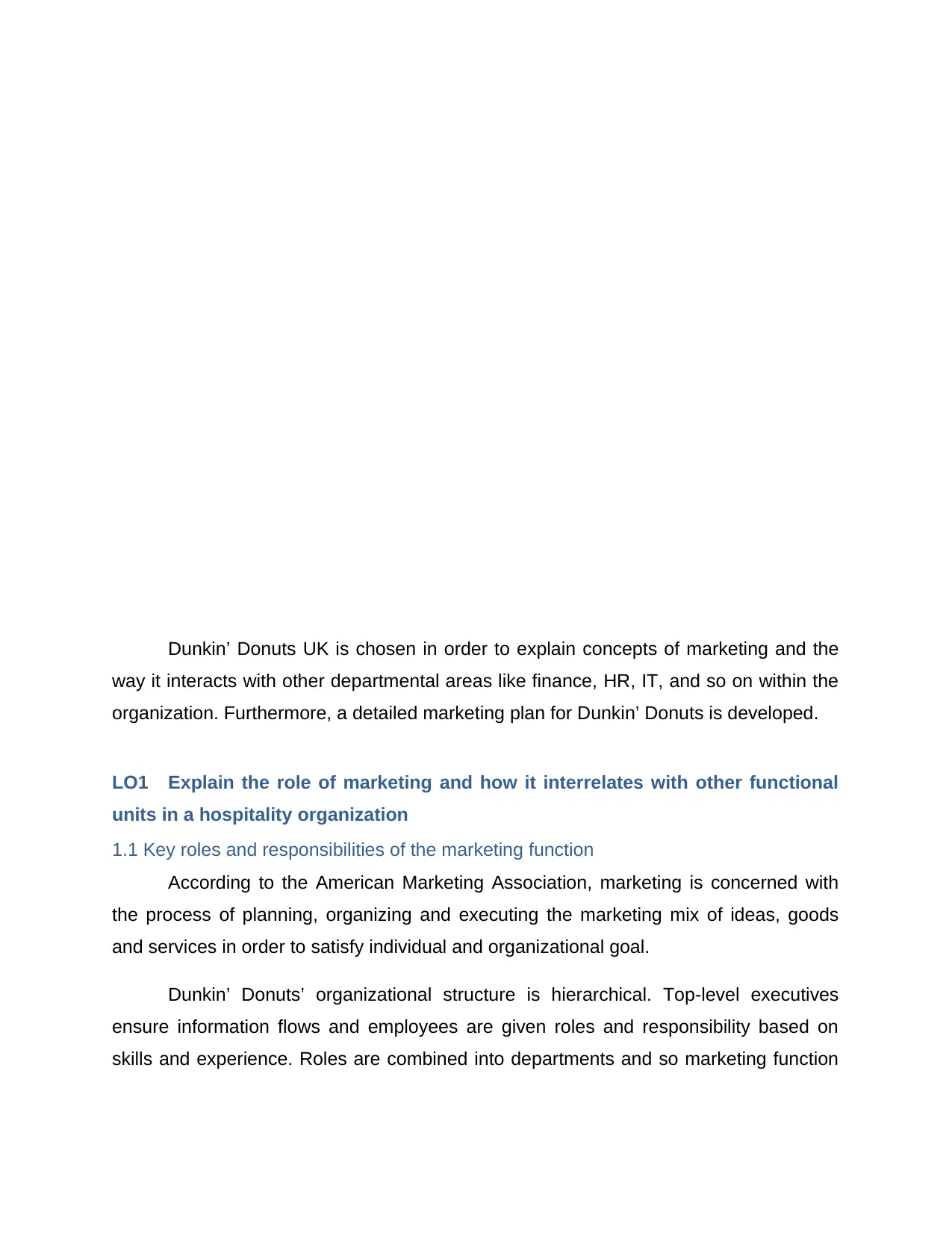
Dunkin’ Donuts UK is chosen in order to explain concepts of marketing and the
way it interacts with other departmental areas like finance, HR, IT, and so on within the
organization. Furthermore, a detailed marketing plan for Dunkin’ Donuts is developed.
LO1 Explain the role of marketing and how it interrelates with other functional
units in a hospitality organization
1.1 Key roles and responsibilities of the marketing function
According to the American Marketing Association, marketing is concerned with
the process of planning, organizing and executing the marketing mix of ideas, goods
and services in order to satisfy individual and organizational goal.
Dunkin’ Donuts’ organizational structure is hierarchical. Top-level executives
ensure information flows and employees are given roles and responsibility based on
skills and experience. Roles are combined into departments and so marketing function
way it interacts with other departmental areas like finance, HR, IT, and so on within the
organization. Furthermore, a detailed marketing plan for Dunkin’ Donuts is developed.
LO1 Explain the role of marketing and how it interrelates with other functional
units in a hospitality organization
1.1 Key roles and responsibilities of the marketing function
According to the American Marketing Association, marketing is concerned with
the process of planning, organizing and executing the marketing mix of ideas, goods
and services in order to satisfy individual and organizational goal.
Dunkin’ Donuts’ organizational structure is hierarchical. Top-level executives
ensure information flows and employees are given roles and responsibility based on
skills and experience. Roles are combined into departments and so marketing function
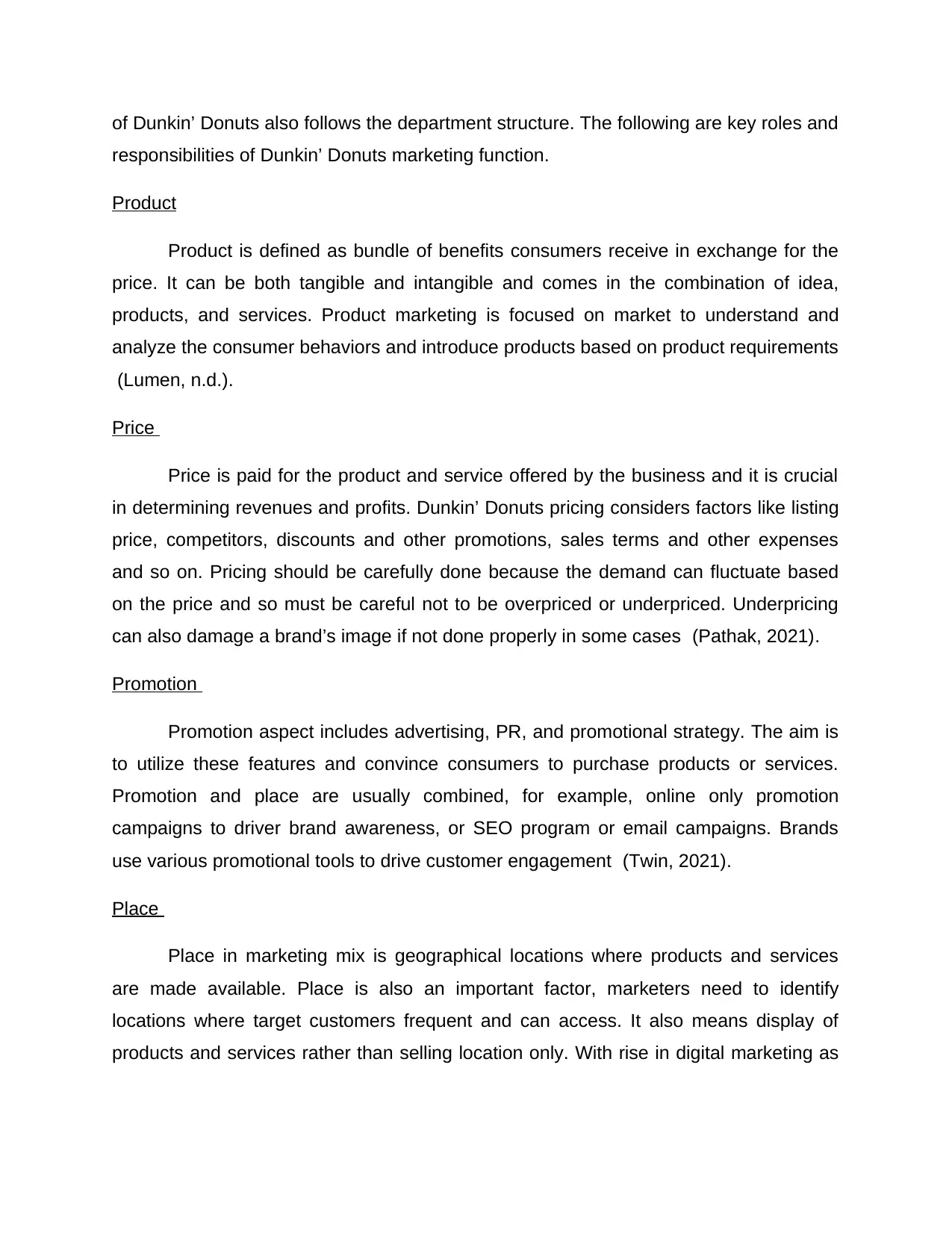
of Dunkin’ Donuts also follows the department structure. The following are key roles and
responsibilities of Dunkin’ Donuts marketing function.
Product
Product is defined as bundle of benefits consumers receive in exchange for the
price. It can be both tangible and intangible and comes in the combination of idea,
products, and services. Product marketing is focused on market to understand and
analyze the consumer behaviors and introduce products based on product requirements
(Lumen, n.d.).
Price
Price is paid for the product and service offered by the business and it is crucial
in determining revenues and profits. Dunkin’ Donuts pricing considers factors like listing
price, competitors, discounts and other promotions, sales terms and other expenses
and so on. Pricing should be carefully done because the demand can fluctuate based
on the price and so must be careful not to be overpriced or underpriced. Underpricing
can also damage a brand’s image if not done properly in some cases (Pathak, 2021).
Promotion
Promotion aspect includes advertising, PR, and promotional strategy. The aim is
to utilize these features and convince consumers to purchase products or services.
Promotion and place are usually combined, for example, online only promotion
campaigns to driver brand awareness, or SEO program or email campaigns. Brands
use various promotional tools to drive customer engagement (Twin, 2021).
Place
Place in marketing mix is geographical locations where products and services
are made available. Place is also an important factor, marketers need to identify
locations where target customers frequent and can access. It also means display of
products and services rather than selling location only. With rise in digital marketing as
responsibilities of Dunkin’ Donuts marketing function.
Product
Product is defined as bundle of benefits consumers receive in exchange for the
price. It can be both tangible and intangible and comes in the combination of idea,
products, and services. Product marketing is focused on market to understand and
analyze the consumer behaviors and introduce products based on product requirements
(Lumen, n.d.).
Price
Price is paid for the product and service offered by the business and it is crucial
in determining revenues and profits. Dunkin’ Donuts pricing considers factors like listing
price, competitors, discounts and other promotions, sales terms and other expenses
and so on. Pricing should be carefully done because the demand can fluctuate based
on the price and so must be careful not to be overpriced or underpriced. Underpricing
can also damage a brand’s image if not done properly in some cases (Pathak, 2021).
Promotion
Promotion aspect includes advertising, PR, and promotional strategy. The aim is
to utilize these features and convince consumers to purchase products or services.
Promotion and place are usually combined, for example, online only promotion
campaigns to driver brand awareness, or SEO program or email campaigns. Brands
use various promotional tools to drive customer engagement (Twin, 2021).
Place
Place in marketing mix is geographical locations where products and services
are made available. Place is also an important factor, marketers need to identify
locations where target customers frequent and can access. It also means display of
products and services rather than selling location only. With rise in digital marketing as
⊘ This is a preview!⊘
Do you want full access?
Subscribe today to unlock all pages.

Trusted by 1+ million students worldwide
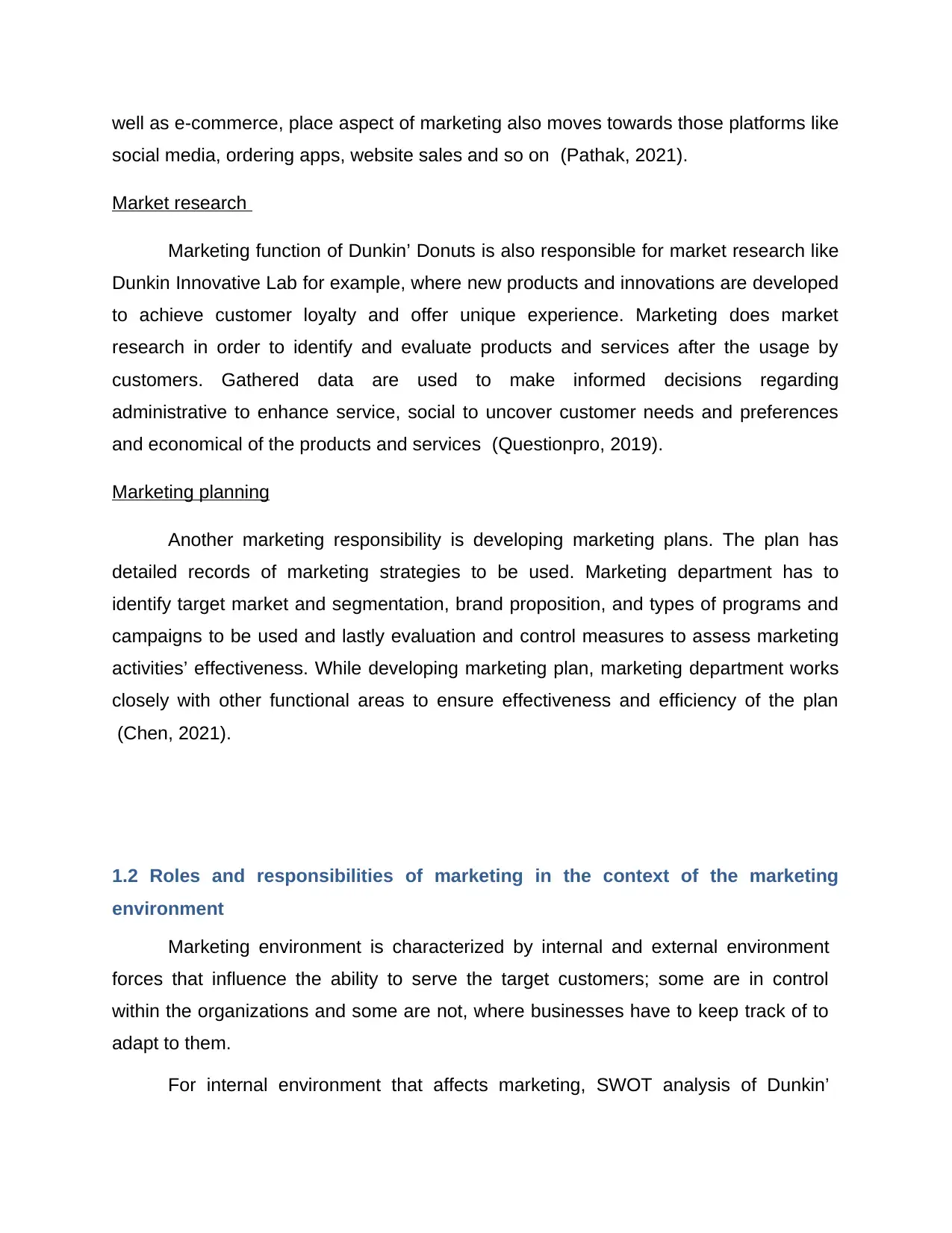
well as e-commerce, place aspect of marketing also moves towards those platforms like
social media, ordering apps, website sales and so on (Pathak, 2021).
Market research
Marketing function of Dunkin’ Donuts is also responsible for market research like
Dunkin Innovative Lab for example, where new products and innovations are developed
to achieve customer loyalty and offer unique experience. Marketing does market
research in order to identify and evaluate products and services after the usage by
customers. Gathered data are used to make informed decisions regarding
administrative to enhance service, social to uncover customer needs and preferences
and economical of the products and services (Questionpro, 2019).
Marketing planning
Another marketing responsibility is developing marketing plans. The plan has
detailed records of marketing strategies to be used. Marketing department has to
identify target market and segmentation, brand proposition, and types of programs and
campaigns to be used and lastly evaluation and control measures to assess marketing
activities’ effectiveness. While developing marketing plan, marketing department works
closely with other functional areas to ensure effectiveness and efficiency of the plan
(Chen, 2021).
1.2 Roles and responsibilities of marketing in the context of the marketing
environment
Marketing environment is characterized by internal and external environment
forces that influence the ability to serve the target customers; some are in control
within the organizations and some are not, where businesses have to keep track of to
adapt to them.
For internal environment that affects marketing, SWOT analysis of Dunkin’
social media, ordering apps, website sales and so on (Pathak, 2021).
Market research
Marketing function of Dunkin’ Donuts is also responsible for market research like
Dunkin Innovative Lab for example, where new products and innovations are developed
to achieve customer loyalty and offer unique experience. Marketing does market
research in order to identify and evaluate products and services after the usage by
customers. Gathered data are used to make informed decisions regarding
administrative to enhance service, social to uncover customer needs and preferences
and economical of the products and services (Questionpro, 2019).
Marketing planning
Another marketing responsibility is developing marketing plans. The plan has
detailed records of marketing strategies to be used. Marketing department has to
identify target market and segmentation, brand proposition, and types of programs and
campaigns to be used and lastly evaluation and control measures to assess marketing
activities’ effectiveness. While developing marketing plan, marketing department works
closely with other functional areas to ensure effectiveness and efficiency of the plan
(Chen, 2021).
1.2 Roles and responsibilities of marketing in the context of the marketing
environment
Marketing environment is characterized by internal and external environment
forces that influence the ability to serve the target customers; some are in control
within the organizations and some are not, where businesses have to keep track of to
adapt to them.
For internal environment that affects marketing, SWOT analysis of Dunkin’
Paraphrase This Document
Need a fresh take? Get an instant paraphrase of this document with our AI Paraphraser
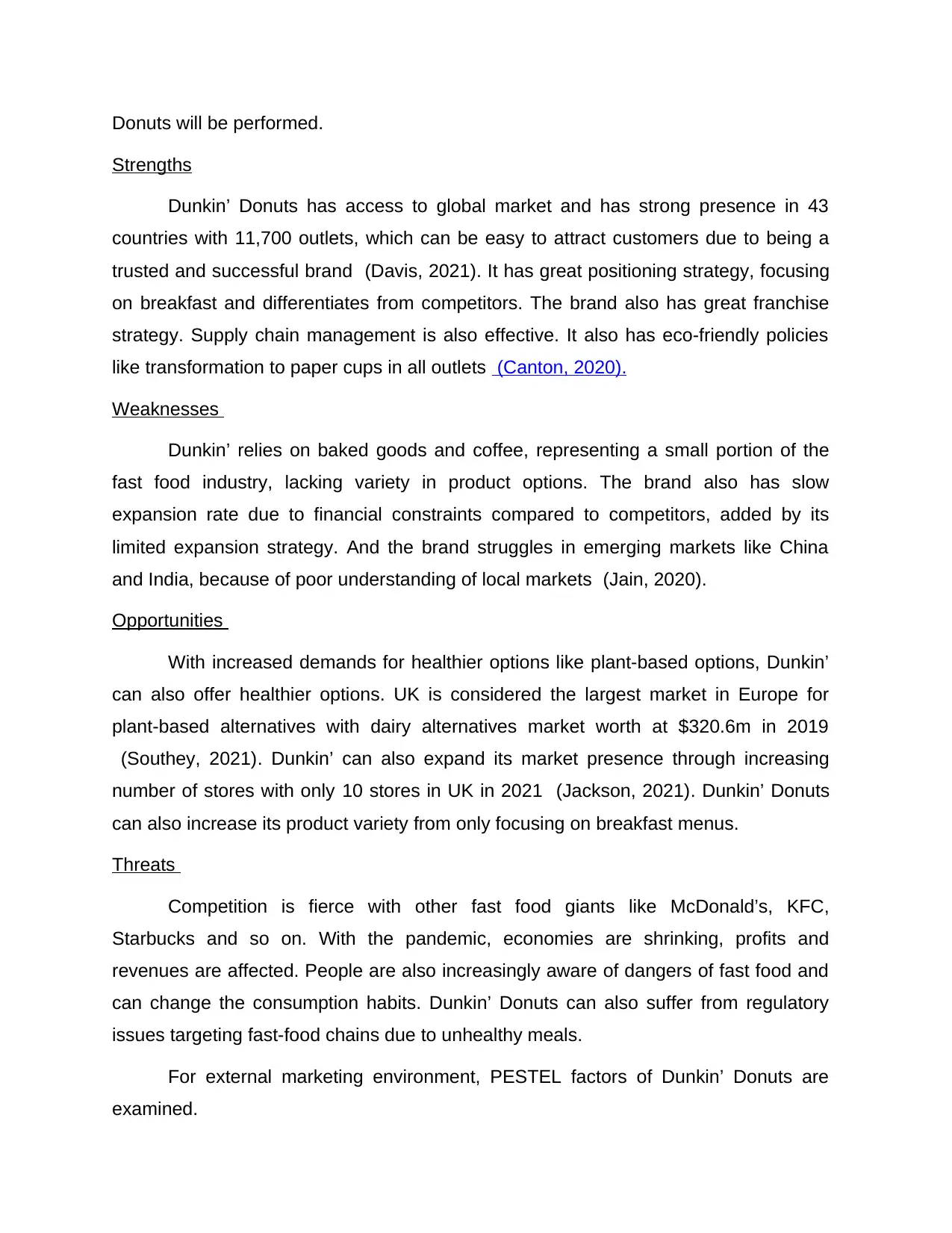
Donuts will be performed.
Strengths
Dunkin’ Donuts has access to global market and has strong presence in 43
countries with 11,700 outlets, which can be easy to attract customers due to being a
trusted and successful brand (Davis, 2021). It has great positioning strategy, focusing
on breakfast and differentiates from competitors. The brand also has great franchise
strategy. Supply chain management is also effective. It also has eco-friendly policies
like transformation to paper cups in all outlets (Canton, 2020).
Weaknesses
Dunkin’ relies on baked goods and coffee, representing a small portion of the
fast food industry, lacking variety in product options. The brand also has slow
expansion rate due to financial constraints compared to competitors, added by its
limited expansion strategy. And the brand struggles in emerging markets like China
and India, because of poor understanding of local markets (Jain, 2020).
Opportunities
With increased demands for healthier options like plant-based options, Dunkin’
can also offer healthier options. UK is considered the largest market in Europe for
plant-based alternatives with dairy alternatives market worth at $320.6m in 2019
(Southey, 2021). Dunkin’ can also expand its market presence through increasing
number of stores with only 10 stores in UK in 2021 (Jackson, 2021). Dunkin’ Donuts
can also increase its product variety from only focusing on breakfast menus.
Threats
Competition is fierce with other fast food giants like McDonald’s, KFC,
Starbucks and so on. With the pandemic, economies are shrinking, profits and
revenues are affected. People are also increasingly aware of dangers of fast food and
can change the consumption habits. Dunkin’ Donuts can also suffer from regulatory
issues targeting fast-food chains due to unhealthy meals.
For external marketing environment, PESTEL factors of Dunkin’ Donuts are
examined.
Strengths
Dunkin’ Donuts has access to global market and has strong presence in 43
countries with 11,700 outlets, which can be easy to attract customers due to being a
trusted and successful brand (Davis, 2021). It has great positioning strategy, focusing
on breakfast and differentiates from competitors. The brand also has great franchise
strategy. Supply chain management is also effective. It also has eco-friendly policies
like transformation to paper cups in all outlets (Canton, 2020).
Weaknesses
Dunkin’ relies on baked goods and coffee, representing a small portion of the
fast food industry, lacking variety in product options. The brand also has slow
expansion rate due to financial constraints compared to competitors, added by its
limited expansion strategy. And the brand struggles in emerging markets like China
and India, because of poor understanding of local markets (Jain, 2020).
Opportunities
With increased demands for healthier options like plant-based options, Dunkin’
can also offer healthier options. UK is considered the largest market in Europe for
plant-based alternatives with dairy alternatives market worth at $320.6m in 2019
(Southey, 2021). Dunkin’ can also expand its market presence through increasing
number of stores with only 10 stores in UK in 2021 (Jackson, 2021). Dunkin’ Donuts
can also increase its product variety from only focusing on breakfast menus.
Threats
Competition is fierce with other fast food giants like McDonald’s, KFC,
Starbucks and so on. With the pandemic, economies are shrinking, profits and
revenues are affected. People are also increasingly aware of dangers of fast food and
can change the consumption habits. Dunkin’ Donuts can also suffer from regulatory
issues targeting fast-food chains due to unhealthy meals.
For external marketing environment, PESTEL factors of Dunkin’ Donuts are
examined.
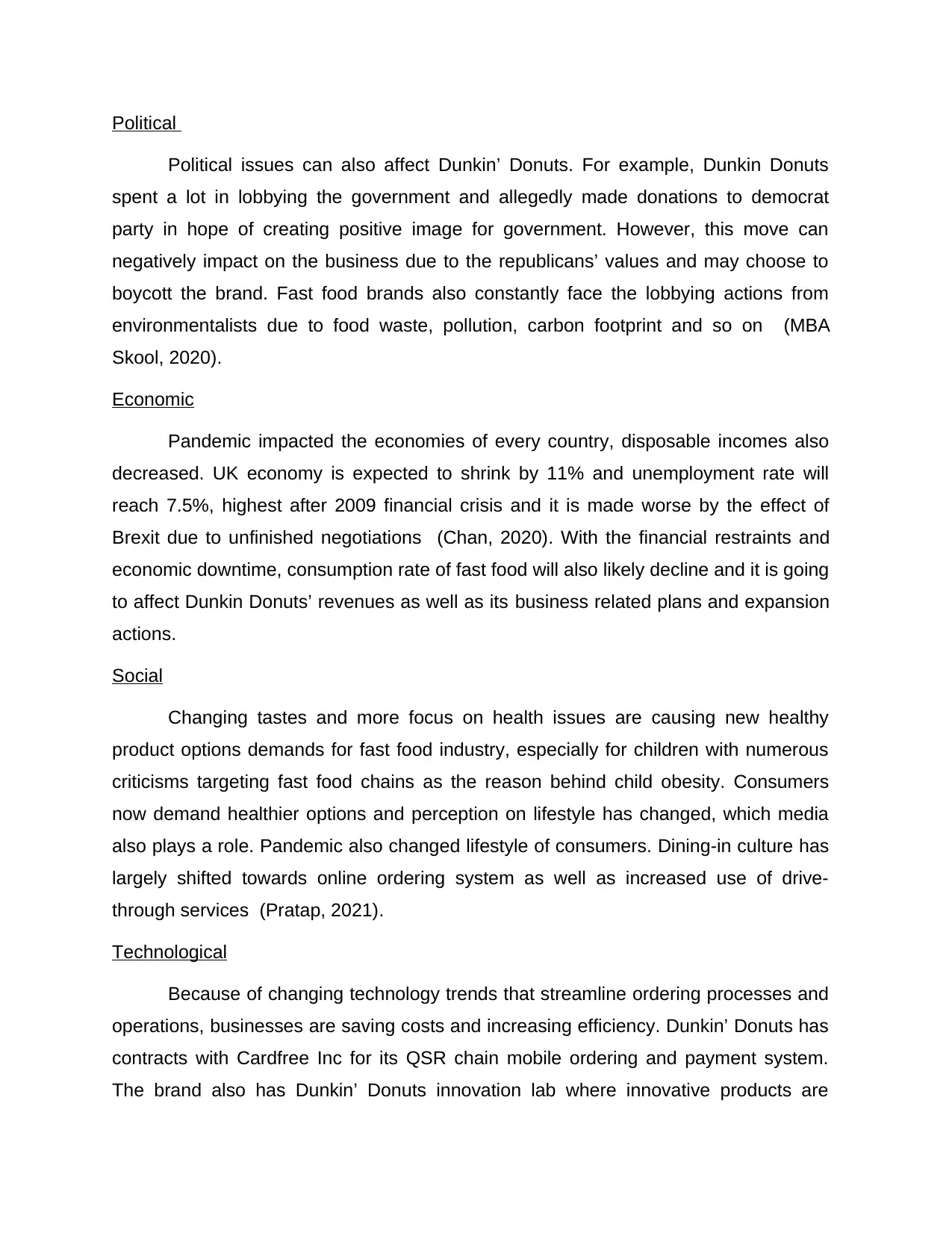
Political
Political issues can also affect Dunkin’ Donuts. For example, Dunkin Donuts
spent a lot in lobbying the government and allegedly made donations to democrat
party in hope of creating positive image for government. However, this move can
negatively impact on the business due to the republicans’ values and may choose to
boycott the brand. Fast food brands also constantly face the lobbying actions from
environmentalists due to food waste, pollution, carbon footprint and so on (MBA
Skool, 2020).
Economic
Pandemic impacted the economies of every country, disposable incomes also
decreased. UK economy is expected to shrink by 11% and unemployment rate will
reach 7.5%, highest after 2009 financial crisis and it is made worse by the effect of
Brexit due to unfinished negotiations (Chan, 2020). With the financial restraints and
economic downtime, consumption rate of fast food will also likely decline and it is going
to affect Dunkin Donuts’ revenues as well as its business related plans and expansion
actions.
Social
Changing tastes and more focus on health issues are causing new healthy
product options demands for fast food industry, especially for children with numerous
criticisms targeting fast food chains as the reason behind child obesity. Consumers
now demand healthier options and perception on lifestyle has changed, which media
also plays a role. Pandemic also changed lifestyle of consumers. Dining-in culture has
largely shifted towards online ordering system as well as increased use of drive-
through services (Pratap, 2021).
Technological
Because of changing technology trends that streamline ordering processes and
operations, businesses are saving costs and increasing efficiency. Dunkin’ Donuts has
contracts with Cardfree Inc for its QSR chain mobile ordering and payment system.
The brand also has Dunkin’ Donuts innovation lab where innovative products are
Political issues can also affect Dunkin’ Donuts. For example, Dunkin Donuts
spent a lot in lobbying the government and allegedly made donations to democrat
party in hope of creating positive image for government. However, this move can
negatively impact on the business due to the republicans’ values and may choose to
boycott the brand. Fast food brands also constantly face the lobbying actions from
environmentalists due to food waste, pollution, carbon footprint and so on (MBA
Skool, 2020).
Economic
Pandemic impacted the economies of every country, disposable incomes also
decreased. UK economy is expected to shrink by 11% and unemployment rate will
reach 7.5%, highest after 2009 financial crisis and it is made worse by the effect of
Brexit due to unfinished negotiations (Chan, 2020). With the financial restraints and
economic downtime, consumption rate of fast food will also likely decline and it is going
to affect Dunkin Donuts’ revenues as well as its business related plans and expansion
actions.
Social
Changing tastes and more focus on health issues are causing new healthy
product options demands for fast food industry, especially for children with numerous
criticisms targeting fast food chains as the reason behind child obesity. Consumers
now demand healthier options and perception on lifestyle has changed, which media
also plays a role. Pandemic also changed lifestyle of consumers. Dining-in culture has
largely shifted towards online ordering system as well as increased use of drive-
through services (Pratap, 2021).
Technological
Because of changing technology trends that streamline ordering processes and
operations, businesses are saving costs and increasing efficiency. Dunkin’ Donuts has
contracts with Cardfree Inc for its QSR chain mobile ordering and payment system.
The brand also has Dunkin’ Donuts innovation lab where innovative products are
⊘ This is a preview!⊘
Do you want full access?
Subscribe today to unlock all pages.

Trusted by 1+ million students worldwide
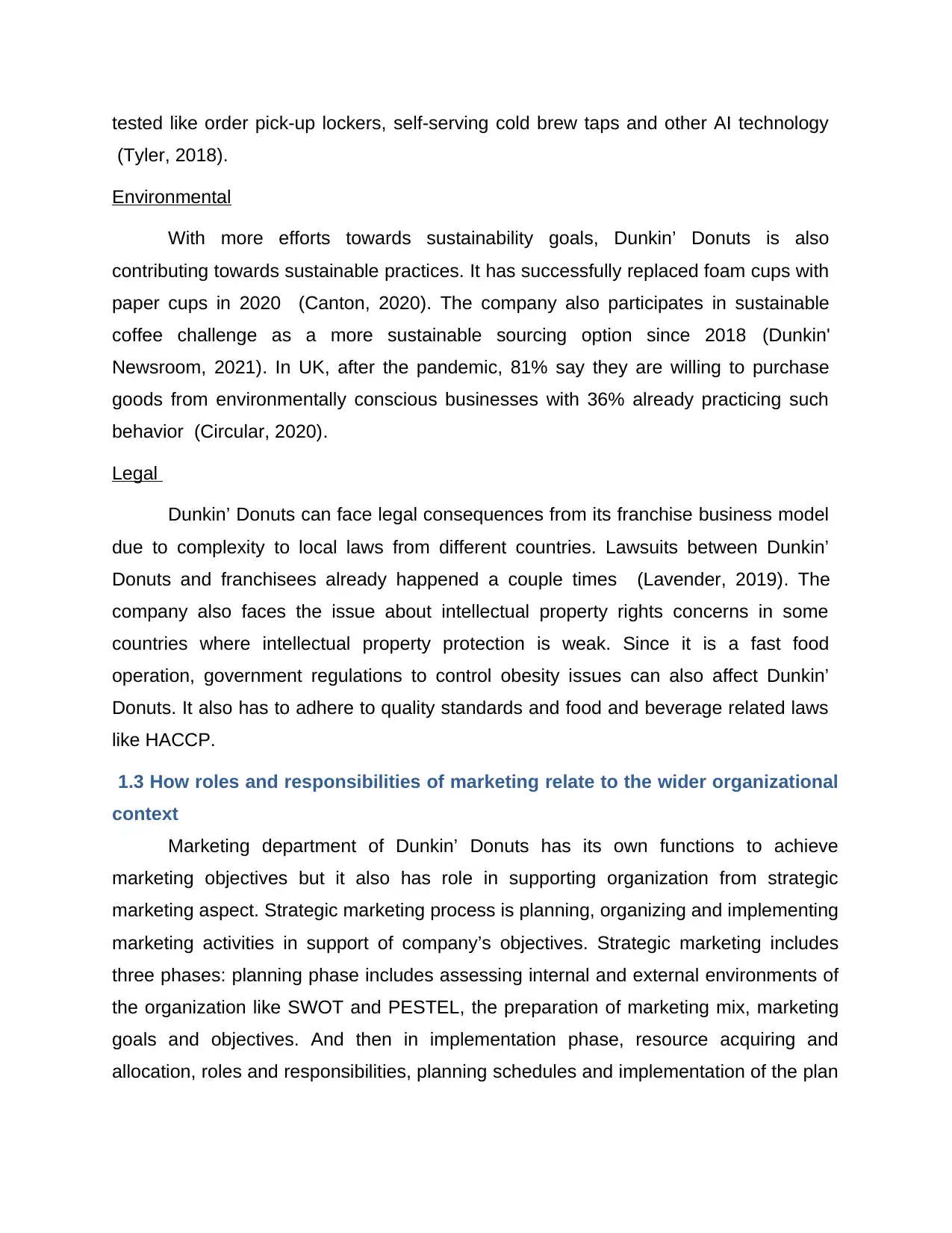
tested like order pick-up lockers, self-serving cold brew taps and other AI technology
(Tyler, 2018).
Environmental
With more efforts towards sustainability goals, Dunkin’ Donuts is also
contributing towards sustainable practices. It has successfully replaced foam cups with
paper cups in 2020 (Canton, 2020). The company also participates in sustainable
coffee challenge as a more sustainable sourcing option since 2018 (Dunkin'
Newsroom, 2021). In UK, after the pandemic, 81% say they are willing to purchase
goods from environmentally conscious businesses with 36% already practicing such
behavior (Circular, 2020).
Legal
Dunkin’ Donuts can face legal consequences from its franchise business model
due to complexity to local laws from different countries. Lawsuits between Dunkin’
Donuts and franchisees already happened a couple times (Lavender, 2019). The
company also faces the issue about intellectual property rights concerns in some
countries where intellectual property protection is weak. Since it is a fast food
operation, government regulations to control obesity issues can also affect Dunkin’
Donuts. It also has to adhere to quality standards and food and beverage related laws
like HACCP.
1.3 How roles and responsibilities of marketing relate to the wider organizational
context
Marketing department of Dunkin’ Donuts has its own functions to achieve
marketing objectives but it also has role in supporting organization from strategic
marketing aspect. Strategic marketing process is planning, organizing and implementing
marketing activities in support of company’s objectives. Strategic marketing includes
three phases: planning phase includes assessing internal and external environments of
the organization like SWOT and PESTEL, the preparation of marketing mix, marketing
goals and objectives. And then in implementation phase, resource acquiring and
allocation, roles and responsibilities, planning schedules and implementation of the plan
(Tyler, 2018).
Environmental
With more efforts towards sustainability goals, Dunkin’ Donuts is also
contributing towards sustainable practices. It has successfully replaced foam cups with
paper cups in 2020 (Canton, 2020). The company also participates in sustainable
coffee challenge as a more sustainable sourcing option since 2018 (Dunkin'
Newsroom, 2021). In UK, after the pandemic, 81% say they are willing to purchase
goods from environmentally conscious businesses with 36% already practicing such
behavior (Circular, 2020).
Legal
Dunkin’ Donuts can face legal consequences from its franchise business model
due to complexity to local laws from different countries. Lawsuits between Dunkin’
Donuts and franchisees already happened a couple times (Lavender, 2019). The
company also faces the issue about intellectual property rights concerns in some
countries where intellectual property protection is weak. Since it is a fast food
operation, government regulations to control obesity issues can also affect Dunkin’
Donuts. It also has to adhere to quality standards and food and beverage related laws
like HACCP.
1.3 How roles and responsibilities of marketing relate to the wider organizational
context
Marketing department of Dunkin’ Donuts has its own functions to achieve
marketing objectives but it also has role in supporting organization from strategic
marketing aspect. Strategic marketing process is planning, organizing and implementing
marketing activities in support of company’s objectives. Strategic marketing includes
three phases: planning phase includes assessing internal and external environments of
the organization like SWOT and PESTEL, the preparation of marketing mix, marketing
goals and objectives. And then in implementation phase, resource acquiring and
allocation, roles and responsibilities, planning schedules and implementation of the plan
Paraphrase This Document
Need a fresh take? Get an instant paraphrase of this document with our AI Paraphraser
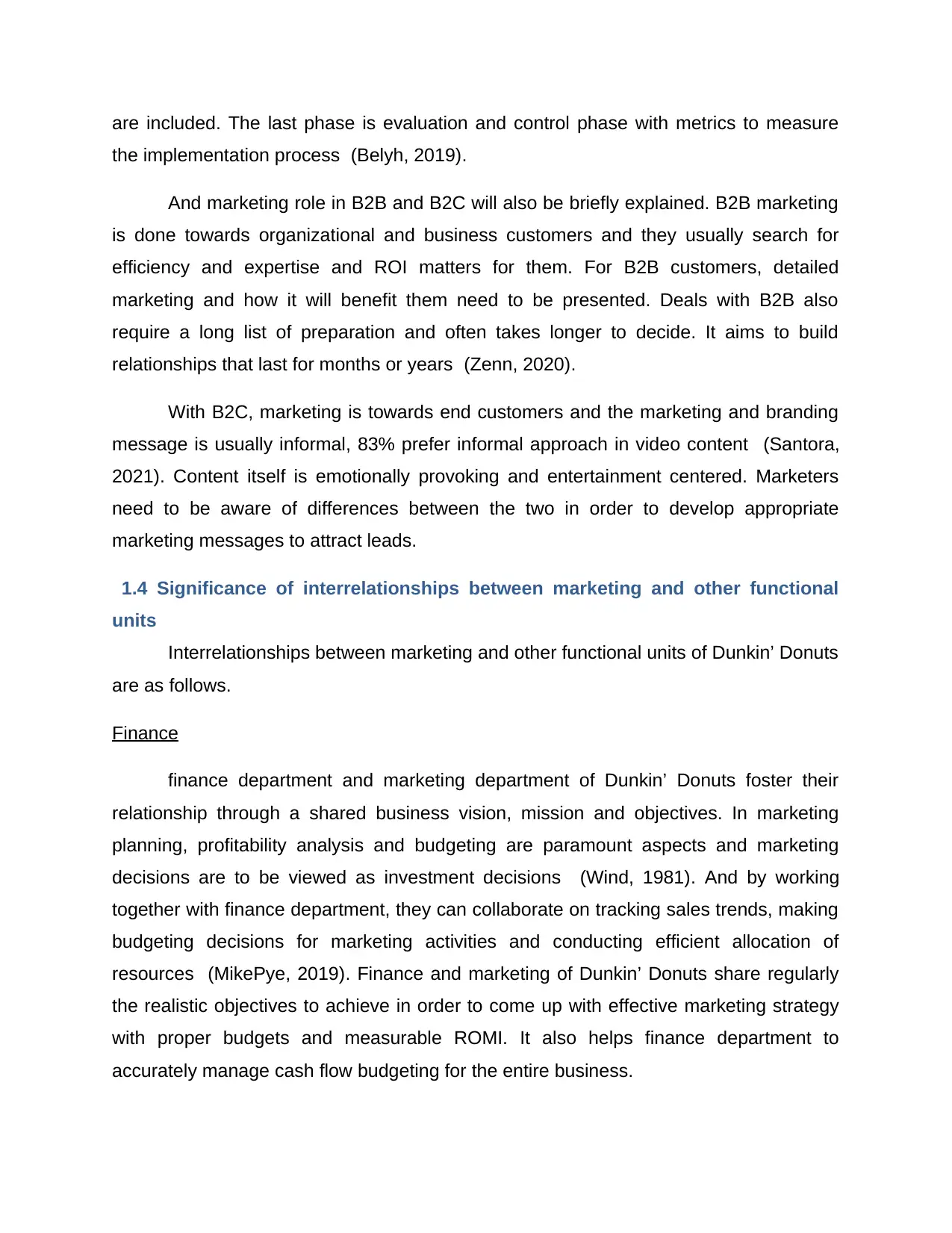
are included. The last phase is evaluation and control phase with metrics to measure
the implementation process (Belyh, 2019).
And marketing role in B2B and B2C will also be briefly explained. B2B marketing
is done towards organizational and business customers and they usually search for
efficiency and expertise and ROI matters for them. For B2B customers, detailed
marketing and how it will benefit them need to be presented. Deals with B2B also
require a long list of preparation and often takes longer to decide. It aims to build
relationships that last for months or years (Zenn, 2020).
With B2C, marketing is towards end customers and the marketing and branding
message is usually informal, 83% prefer informal approach in video content (Santora,
2021). Content itself is emotionally provoking and entertainment centered. Marketers
need to be aware of differences between the two in order to develop appropriate
marketing messages to attract leads.
1.4 Significance of interrelationships between marketing and other functional
units
Interrelationships between marketing and other functional units of Dunkin’ Donuts
are as follows.
Finance
finance department and marketing department of Dunkin’ Donuts foster their
relationship through a shared business vision, mission and objectives. In marketing
planning, profitability analysis and budgeting are paramount aspects and marketing
decisions are to be viewed as investment decisions (Wind, 1981). And by working
together with finance department, they can collaborate on tracking sales trends, making
budgeting decisions for marketing activities and conducting efficient allocation of
resources (MikePye, 2019). Finance and marketing of Dunkin’ Donuts share regularly
the realistic objectives to achieve in order to come up with effective marketing strategy
with proper budgets and measurable ROMI. It also helps finance department to
accurately manage cash flow budgeting for the entire business.
the implementation process (Belyh, 2019).
And marketing role in B2B and B2C will also be briefly explained. B2B marketing
is done towards organizational and business customers and they usually search for
efficiency and expertise and ROI matters for them. For B2B customers, detailed
marketing and how it will benefit them need to be presented. Deals with B2B also
require a long list of preparation and often takes longer to decide. It aims to build
relationships that last for months or years (Zenn, 2020).
With B2C, marketing is towards end customers and the marketing and branding
message is usually informal, 83% prefer informal approach in video content (Santora,
2021). Content itself is emotionally provoking and entertainment centered. Marketers
need to be aware of differences between the two in order to develop appropriate
marketing messages to attract leads.
1.4 Significance of interrelationships between marketing and other functional
units
Interrelationships between marketing and other functional units of Dunkin’ Donuts
are as follows.
Finance
finance department and marketing department of Dunkin’ Donuts foster their
relationship through a shared business vision, mission and objectives. In marketing
planning, profitability analysis and budgeting are paramount aspects and marketing
decisions are to be viewed as investment decisions (Wind, 1981). And by working
together with finance department, they can collaborate on tracking sales trends, making
budgeting decisions for marketing activities and conducting efficient allocation of
resources (MikePye, 2019). Finance and marketing of Dunkin’ Donuts share regularly
the realistic objectives to achieve in order to come up with effective marketing strategy
with proper budgets and measurable ROMI. It also helps finance department to
accurately manage cash flow budgeting for the entire business.
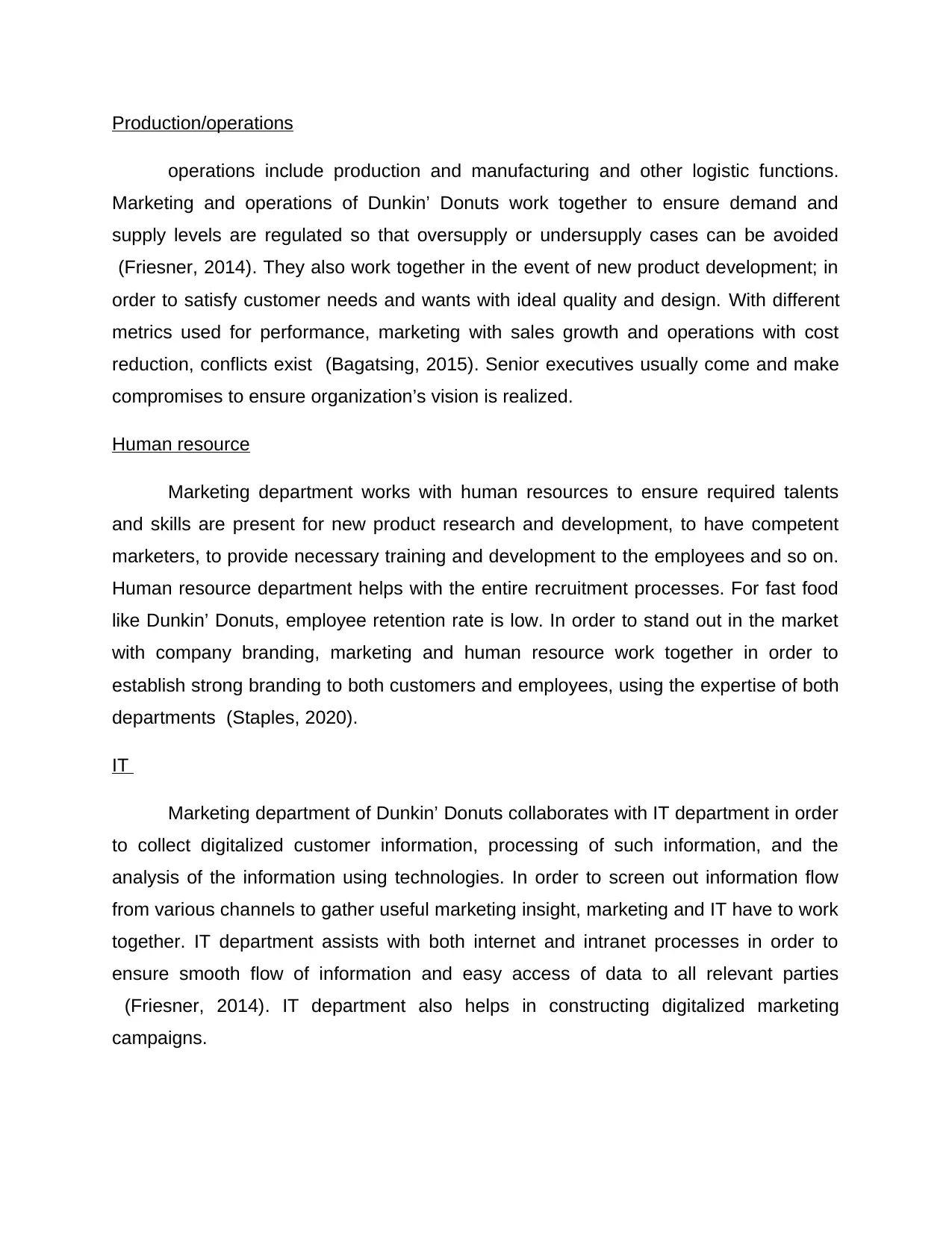
Production/operations
operations include production and manufacturing and other logistic functions.
Marketing and operations of Dunkin’ Donuts work together to ensure demand and
supply levels are regulated so that oversupply or undersupply cases can be avoided
(Friesner, 2014). They also work together in the event of new product development; in
order to satisfy customer needs and wants with ideal quality and design. With different
metrics used for performance, marketing with sales growth and operations with cost
reduction, conflicts exist (Bagatsing, 2015). Senior executives usually come and make
compromises to ensure organization’s vision is realized.
Human resource
Marketing department works with human resources to ensure required talents
and skills are present for new product research and development, to have competent
marketers, to provide necessary training and development to the employees and so on.
Human resource department helps with the entire recruitment processes. For fast food
like Dunkin’ Donuts, employee retention rate is low. In order to stand out in the market
with company branding, marketing and human resource work together in order to
establish strong branding to both customers and employees, using the expertise of both
departments (Staples, 2020).
IT
Marketing department of Dunkin’ Donuts collaborates with IT department in order
to collect digitalized customer information, processing of such information, and the
analysis of the information using technologies. In order to screen out information flow
from various channels to gather useful marketing insight, marketing and IT have to work
together. IT department assists with both internet and intranet processes in order to
ensure smooth flow of information and easy access of data to all relevant parties
(Friesner, 2014). IT department also helps in constructing digitalized marketing
campaigns.
operations include production and manufacturing and other logistic functions.
Marketing and operations of Dunkin’ Donuts work together to ensure demand and
supply levels are regulated so that oversupply or undersupply cases can be avoided
(Friesner, 2014). They also work together in the event of new product development; in
order to satisfy customer needs and wants with ideal quality and design. With different
metrics used for performance, marketing with sales growth and operations with cost
reduction, conflicts exist (Bagatsing, 2015). Senior executives usually come and make
compromises to ensure organization’s vision is realized.
Human resource
Marketing department works with human resources to ensure required talents
and skills are present for new product research and development, to have competent
marketers, to provide necessary training and development to the employees and so on.
Human resource department helps with the entire recruitment processes. For fast food
like Dunkin’ Donuts, employee retention rate is low. In order to stand out in the market
with company branding, marketing and human resource work together in order to
establish strong branding to both customers and employees, using the expertise of both
departments (Staples, 2020).
IT
Marketing department of Dunkin’ Donuts collaborates with IT department in order
to collect digitalized customer information, processing of such information, and the
analysis of the information using technologies. In order to screen out information flow
from various channels to gather useful marketing insight, marketing and IT have to work
together. IT department assists with both internet and intranet processes in order to
ensure smooth flow of information and easy access of data to all relevant parties
(Friesner, 2014). IT department also helps in constructing digitalized marketing
campaigns.
⊘ This is a preview!⊘
Do you want full access?
Subscribe today to unlock all pages.

Trusted by 1+ million students worldwide
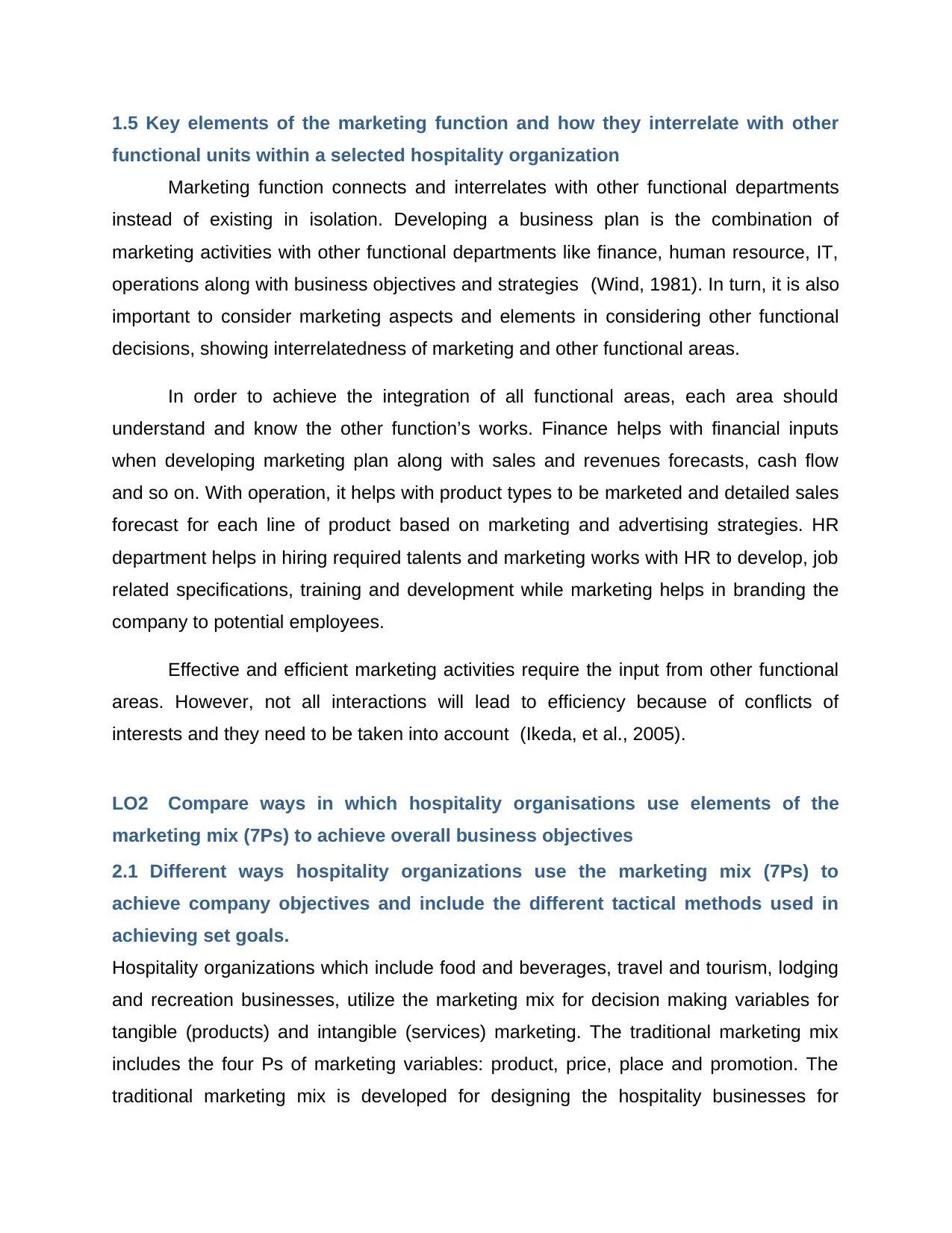
1.5 Key elements of the marketing function and how they interrelate with other
functional units within a selected hospitality organization
Marketing function connects and interrelates with other functional departments
instead of existing in isolation. Developing a business plan is the combination of
marketing activities with other functional departments like finance, human resource, IT,
operations along with business objectives and strategies (Wind, 1981). In turn, it is also
important to consider marketing aspects and elements in considering other functional
decisions, showing interrelatedness of marketing and other functional areas.
In order to achieve the integration of all functional areas, each area should
understand and know the other function’s works. Finance helps with financial inputs
when developing marketing plan along with sales and revenues forecasts, cash flow
and so on. With operation, it helps with product types to be marketed and detailed sales
forecast for each line of product based on marketing and advertising strategies. HR
department helps in hiring required talents and marketing works with HR to develop, job
related specifications, training and development while marketing helps in branding the
company to potential employees.
Effective and efficient marketing activities require the input from other functional
areas. However, not all interactions will lead to efficiency because of conflicts of
interests and they need to be taken into account (Ikeda, et al., 2005).
LO2 Compare ways in which hospitality organisations use elements of the
marketing mix (7Ps) to achieve overall business objectives
2.1 Different ways hospitality organizations use the marketing mix (7Ps) to
achieve company objectives and include the different tactical methods used in
achieving set goals.
Hospitality organizations which include food and beverages, travel and tourism, lodging
and recreation businesses, utilize the marketing mix for decision making variables for
tangible (products) and intangible (services) marketing. The traditional marketing mix
includes the four Ps of marketing variables: product, price, place and promotion. The
traditional marketing mix is developed for designing the hospitality businesses for
functional units within a selected hospitality organization
Marketing function connects and interrelates with other functional departments
instead of existing in isolation. Developing a business plan is the combination of
marketing activities with other functional departments like finance, human resource, IT,
operations along with business objectives and strategies (Wind, 1981). In turn, it is also
important to consider marketing aspects and elements in considering other functional
decisions, showing interrelatedness of marketing and other functional areas.
In order to achieve the integration of all functional areas, each area should
understand and know the other function’s works. Finance helps with financial inputs
when developing marketing plan along with sales and revenues forecasts, cash flow
and so on. With operation, it helps with product types to be marketed and detailed sales
forecast for each line of product based on marketing and advertising strategies. HR
department helps in hiring required talents and marketing works with HR to develop, job
related specifications, training and development while marketing helps in branding the
company to potential employees.
Effective and efficient marketing activities require the input from other functional
areas. However, not all interactions will lead to efficiency because of conflicts of
interests and they need to be taken into account (Ikeda, et al., 2005).
LO2 Compare ways in which hospitality organisations use elements of the
marketing mix (7Ps) to achieve overall business objectives
2.1 Different ways hospitality organizations use the marketing mix (7Ps) to
achieve company objectives and include the different tactical methods used in
achieving set goals.
Hospitality organizations which include food and beverages, travel and tourism, lodging
and recreation businesses, utilize the marketing mix for decision making variables for
tangible (products) and intangible (services) marketing. The traditional marketing mix
includes the four Ps of marketing variables: product, price, place and promotion. The
traditional marketing mix is developed for designing the hospitality businesses for
Paraphrase This Document
Need a fresh take? Get an instant paraphrase of this document with our AI Paraphraser
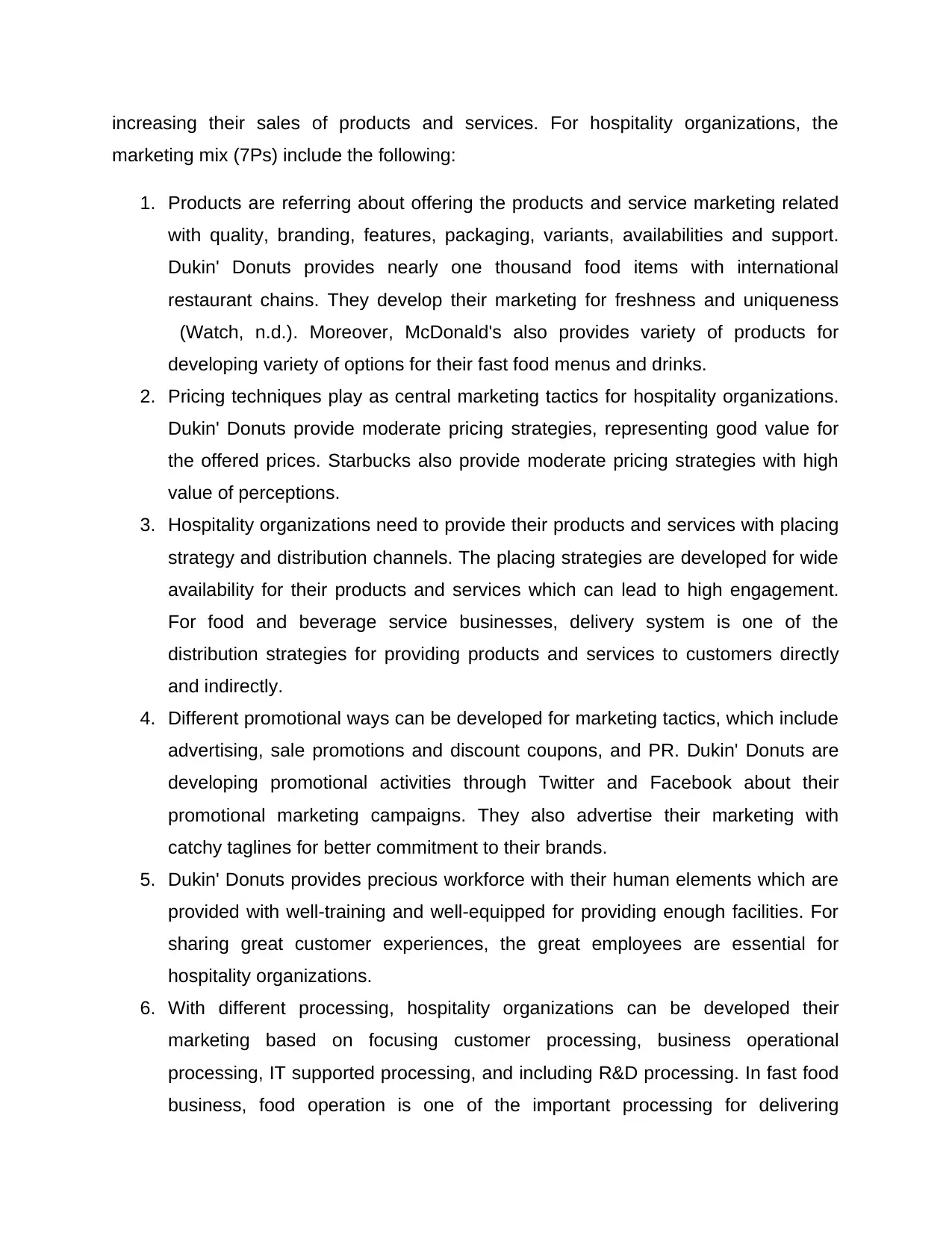
increasing their sales of products and services. For hospitality organizations, the
marketing mix (7Ps) include the following:
1. Products are referring about offering the products and service marketing related
with quality, branding, features, packaging, variants, availabilities and support.
Dukin' Donuts provides nearly one thousand food items with international
restaurant chains. They develop their marketing for freshness and uniqueness
(Watch, n.d.). Moreover, McDonald's also provides variety of products for
developing variety of options for their fast food menus and drinks.
2. Pricing techniques play as central marketing tactics for hospitality organizations.
Dukin' Donuts provide moderate pricing strategies, representing good value for
the offered prices. Starbucks also provide moderate pricing strategies with high
value of perceptions.
3. Hospitality organizations need to provide their products and services with placing
strategy and distribution channels. The placing strategies are developed for wide
availability for their products and services which can lead to high engagement.
For food and beverage service businesses, delivery system is one of the
distribution strategies for providing products and services to customers directly
and indirectly.
4. Different promotional ways can be developed for marketing tactics, which include
advertising, sale promotions and discount coupons, and PR. Dukin' Donuts are
developing promotional activities through Twitter and Facebook about their
promotional marketing campaigns. They also advertise their marketing with
catchy taglines for better commitment to their brands.
5. Dukin' Donuts provides precious workforce with their human elements which are
provided with well-training and well-equipped for providing enough facilities. For
sharing great customer experiences, the great employees are essential for
hospitality organizations.
6. With different processing, hospitality organizations can be developed their
marketing based on focusing customer processing, business operational
processing, IT supported processing, and including R&D processing. In fast food
business, food operation is one of the important processing for delivering
marketing mix (7Ps) include the following:
1. Products are referring about offering the products and service marketing related
with quality, branding, features, packaging, variants, availabilities and support.
Dukin' Donuts provides nearly one thousand food items with international
restaurant chains. They develop their marketing for freshness and uniqueness
(Watch, n.d.). Moreover, McDonald's also provides variety of products for
developing variety of options for their fast food menus and drinks.
2. Pricing techniques play as central marketing tactics for hospitality organizations.
Dukin' Donuts provide moderate pricing strategies, representing good value for
the offered prices. Starbucks also provide moderate pricing strategies with high
value of perceptions.
3. Hospitality organizations need to provide their products and services with placing
strategy and distribution channels. The placing strategies are developed for wide
availability for their products and services which can lead to high engagement.
For food and beverage service businesses, delivery system is one of the
distribution strategies for providing products and services to customers directly
and indirectly.
4. Different promotional ways can be developed for marketing tactics, which include
advertising, sale promotions and discount coupons, and PR. Dukin' Donuts are
developing promotional activities through Twitter and Facebook about their
promotional marketing campaigns. They also advertise their marketing with
catchy taglines for better commitment to their brands.
5. Dukin' Donuts provides precious workforce with their human elements which are
provided with well-training and well-equipped for providing enough facilities. For
sharing great customer experiences, the great employees are essential for
hospitality organizations.
6. With different processing, hospitality organizations can be developed their
marketing based on focusing customer processing, business operational
processing, IT supported processing, and including R&D processing. In fast food
business, food operation is one of the important processing for delivering
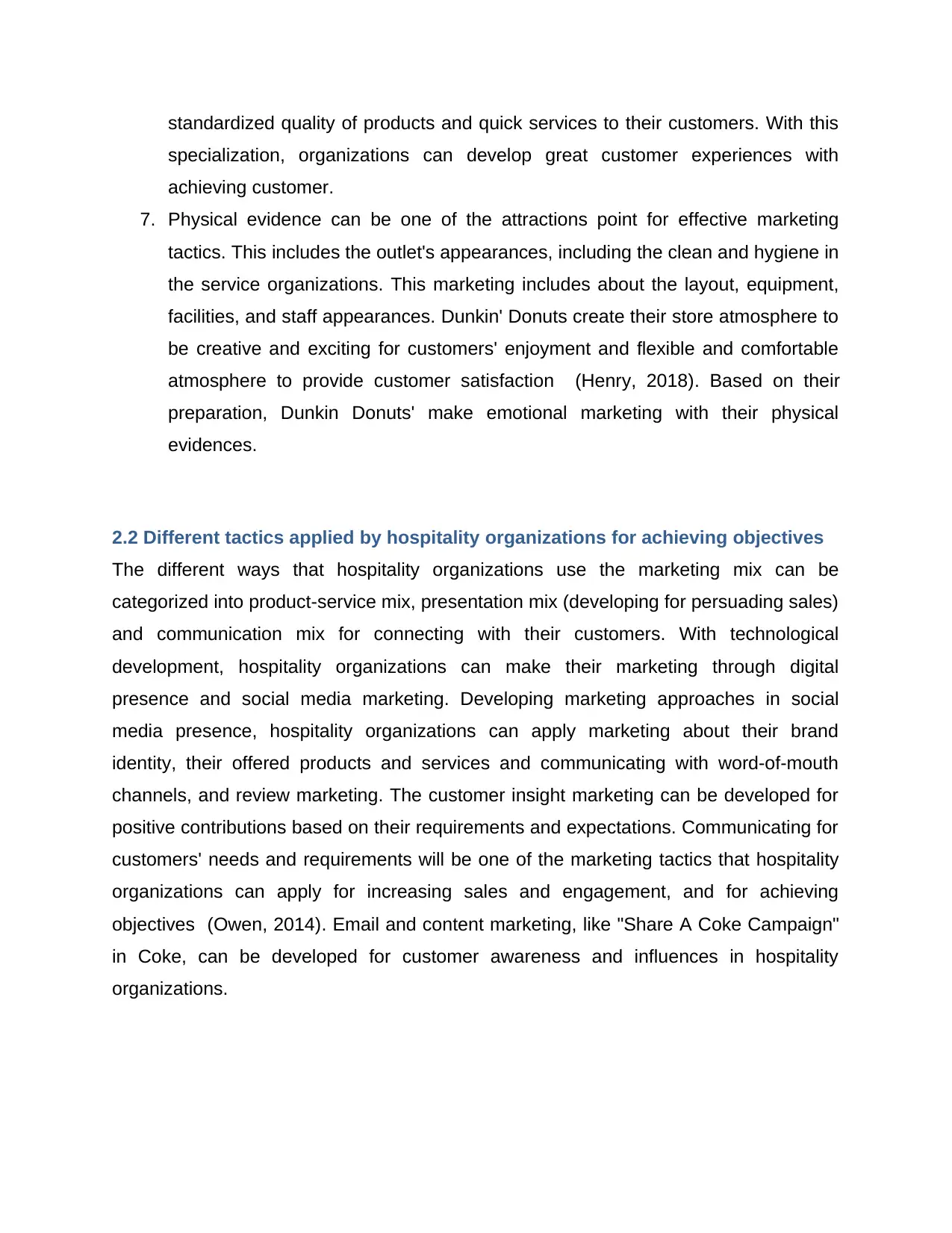
standardized quality of products and quick services to their customers. With this
specialization, organizations can develop great customer experiences with
achieving customer.
7. Physical evidence can be one of the attractions point for effective marketing
tactics. This includes the outlet's appearances, including the clean and hygiene in
the service organizations. This marketing includes about the layout, equipment,
facilities, and staff appearances. Dunkin' Donuts create their store atmosphere to
be creative and exciting for customers' enjoyment and flexible and comfortable
atmosphere to provide customer satisfaction (Henry, 2018). Based on their
preparation, Dunkin Donuts' make emotional marketing with their physical
evidences.
2.2 Different tactics applied by hospitality organizations for achieving objectives
The different ways that hospitality organizations use the marketing mix can be
categorized into product-service mix, presentation mix (developing for persuading sales)
and communication mix for connecting with their customers. With technological
development, hospitality organizations can make their marketing through digital
presence and social media marketing. Developing marketing approaches in social
media presence, hospitality organizations can apply marketing about their brand
identity, their offered products and services and communicating with word-of-mouth
channels, and review marketing. The customer insight marketing can be developed for
positive contributions based on their requirements and expectations. Communicating for
customers' needs and requirements will be one of the marketing tactics that hospitality
organizations can apply for increasing sales and engagement, and for achieving
objectives (Owen, 2014). Email and content marketing, like "Share A Coke Campaign"
in Coke, can be developed for customer awareness and influences in hospitality
organizations.
specialization, organizations can develop great customer experiences with
achieving customer.
7. Physical evidence can be one of the attractions point for effective marketing
tactics. This includes the outlet's appearances, including the clean and hygiene in
the service organizations. This marketing includes about the layout, equipment,
facilities, and staff appearances. Dunkin' Donuts create their store atmosphere to
be creative and exciting for customers' enjoyment and flexible and comfortable
atmosphere to provide customer satisfaction (Henry, 2018). Based on their
preparation, Dunkin Donuts' make emotional marketing with their physical
evidences.
2.2 Different tactics applied by hospitality organizations for achieving objectives
The different ways that hospitality organizations use the marketing mix can be
categorized into product-service mix, presentation mix (developing for persuading sales)
and communication mix for connecting with their customers. With technological
development, hospitality organizations can make their marketing through digital
presence and social media marketing. Developing marketing approaches in social
media presence, hospitality organizations can apply marketing about their brand
identity, their offered products and services and communicating with word-of-mouth
channels, and review marketing. The customer insight marketing can be developed for
positive contributions based on their requirements and expectations. Communicating for
customers' needs and requirements will be one of the marketing tactics that hospitality
organizations can apply for increasing sales and engagement, and for achieving
objectives (Owen, 2014). Email and content marketing, like "Share A Coke Campaign"
in Coke, can be developed for customer awareness and influences in hospitality
organizations.
⊘ This is a preview!⊘
Do you want full access?
Subscribe today to unlock all pages.

Trusted by 1+ million students worldwide
1 out of 25
Related Documents
Your All-in-One AI-Powered Toolkit for Academic Success.
+13062052269
info@desklib.com
Available 24*7 on WhatsApp / Email
![[object Object]](/_next/static/media/star-bottom.7253800d.svg)
Unlock your academic potential
Copyright © 2020–2025 A2Z Services. All Rights Reserved. Developed and managed by ZUCOL.


